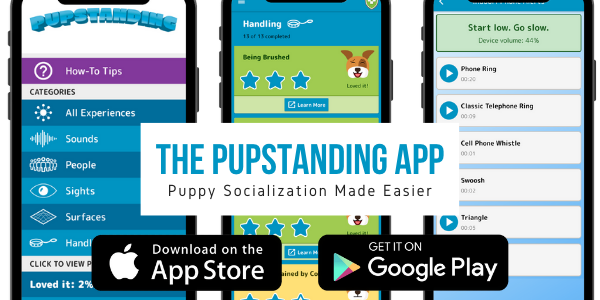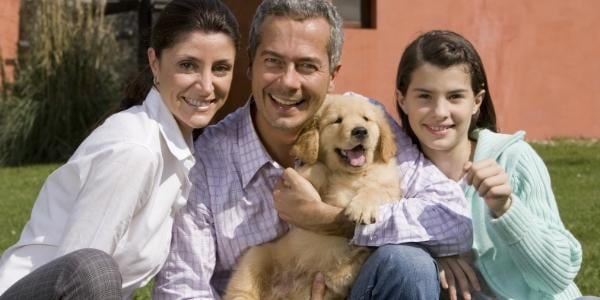 Bringing a puppy home for the first time is exciting, fun, and exhausting — all rolled into one!
Bringing a puppy home for the first time is exciting, fun, and exhausting — all rolled into one!
If you’ve brought home a new puppy, the advice on everything you should be doing to raise them to be a well-behaved and happy dog can feel overwhelming.
Many puppy parents go through what’s called the “puppy blues” — sleep-deprived, frustrated, stressed, and regretting the decision to bring home that little furball. It can be hard to enjoy the adorable puppy antics right after you’ve cleaned up yet another potty accident, or have fun playing with your puppy when they keep nipping at your hands.
While raising a puppy is hard work, it’s also an incredibly rewarding experience. Building a relationship with a completely different species and helping them learn how to navigate in our world is an amazing feat! You don’t have to do everything all at once. Avoid puppy burnout by focusing on essential behaviors first.
I want to share what I believe are the three most important things to focus on during the first few weeks after bringing a puppy home. These things will build a strong foundation for everything else your puppy will learn later on.
You can always add in basic obedience cues to these (such as these 6 training skills to keep your puppy safe), but don't feel bad if your puppy doesn't learn a perfect sit or stay right off the bat. The topics below are a higher priority in the short term, and lay a foundation for excellent obedience and behavior in the long term!
1. Puppy Socialization
Your puppy goes through a crucial developmental stage called the “socialization period” from around 7 weeks of age to 16 weeks of age. During this time, their brain is primed and ready to learn about the big wide world and make lasting associations (positive or negative) with what they experience. Proper early socialization is essential for helping to build confidence, decrease fear, and make future life experiences positive and less stressful for all.
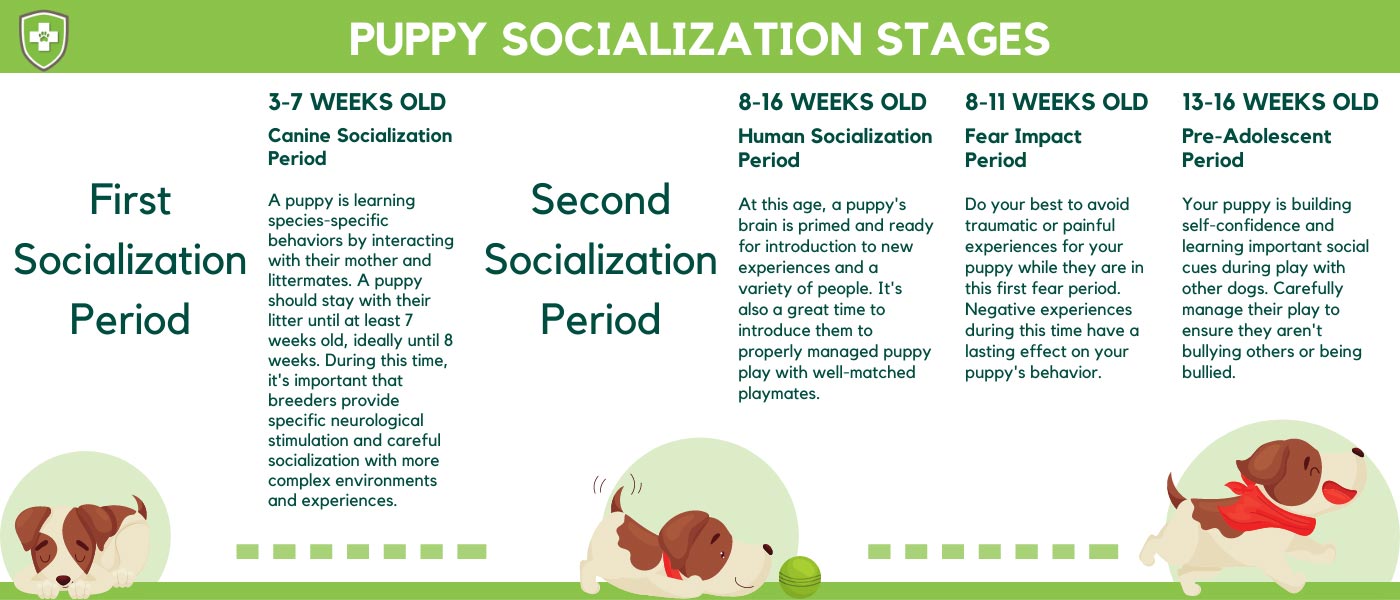
The goal is to create positive associations for things your puppy will experience throughout their life, so they have positive emotional reactions, or at minimum neutral reactions, to when these things happen later down the road. It’s all about building confidence and resiliency in your puppy. The more they learn that new and unfamiliar things predict good things for them, the easier it is to handle new and sometimes stressful experiences going forward.
Socialization isn't just about meeting new people and other dogs though! In fact, interacting with new people and dogs is just a small slice of puppy socialization. Think about all of your puppy’s senses when working on socialization — the goal is to help them learn about all the different experiences they'll have throughout their life and be able to cope with novel sights, sounds, texture under their feet, handling, and more.
Here are some examples of puppy socialization goals:
- A flag blowing in the wind while on a walk = nothing to be scared of!
- Getting into and out of a slippery bathtub = no big deal!
- Standing on an exam table while being handled by veterinary staff = calm and positive experience!
- Walking calmly by another dog = treats from you!
- Fireworks or thunderstorms = not a favorite, but I can cope!
- A person riding by on a bicycle = easy peasy!
Enroll in our Puppy Essentials: Socialization Foundations Workshop to get access to in-depth socialization exercises you can begin right away with video examples, step-by-step instructions, and more!
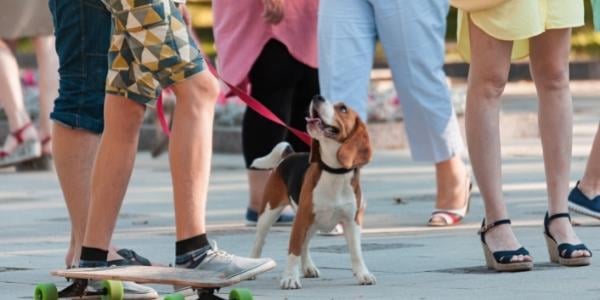
Start Low, Go Slow. Keep It Short & Sweet!
The best way to go about socialization is to start low and go slow.
Don’t overwhelm your puppy with new things by starting too close to something or someone new. Slowly increase their exposure to the new thing over time, always keeping an eye out for signs of stress or fear. If they are telling you with their body language that they’re nervous about something, such as a tucked tail, wide eyes, ears pinned back, or trying to hide behind you or run away, move further away or stop the activity. Next time, start at a lower intensity.
Keep your socialization practice short and sweet!
Use high-value treats to reward your puppy for being calm in new situations or seeing something new in the distance. If they love to play with toys, have playtime while playing new sounds at a low volume in the background. Give your puppy ample time to decompress after new experiences, as this allows their brain to absorb what they’ve learned and helps prevent overstimulation.
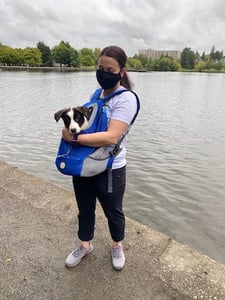 Socialize safely while waiting for puppy vaccinations.
Socialize safely while waiting for puppy vaccinations.
Be aware of appropriate socialization activities while your puppy is completing their puppy vaccinations. There are lots of ways to still expose them to different environments while protecting them from disease and illness, such as having them in a puppy backpack, stroller, or even just sitting with them in the backseat of your car at the edge of a park or store parking lot.
Track Your Puppy's Socialization Progress
For a helpful puppy socialization checklist and more socialization tips, download the free smartphone Pupstanding App. There are in-app audio recordings for sound socialization and in-depth resources for each aspect of puppy socialization. You can track different experiences and grade your puppy’s response to these things, making it easy to share with your trainer and plan future socialization practice.
Have you brought home an older puppy or adopted dog? Learn what you can do in "How to Help a Dog Who Missed Early Socialization."
2. Potty Training
Getting your new pup on a consistent house-training schedule will save you a lot of stress, cleaning, and set them up for a lifetime of appropriate potty habits. While the first few weeks of potty training involve nighttime potty breaks (less sleep for you) and consistent supervision, the more consistent you are at the start means the faster your puppy will learn!
Your puppy needs time to physically mature enough to “hold it” for longer periods. Plan for frequent potty breaks — you’re going to feel like you’re taking your puppy outside to potty ALL OF THE TIME. But the more opportunity they have to go in the designated place, the less chance they have of an indoor accident! Reward them for going to the bathroom at their potty spot.
As they finish up their business, calmly say “yes!” and give them a tiny treat. As they grow and learn, they’ll prefer to go potty in that spot rather than soil where they sleep, eat, or play. It just takes time and consistency for them to build this habit.
Keeping a potty log can be helpful to plan your puppy’s potty breaks, keep track of when they go and don’t go (perfect if you have multiple people taking them on potty breaks), and see if there are any patterns when it comes to accidents.
Download a free Potty Log template here.
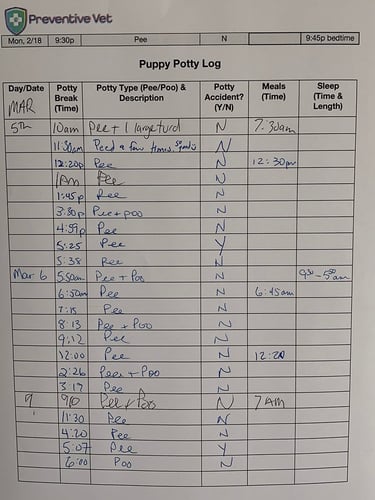
For a step-by-step guide and potty training tips, check out the following articles:
- How to Potty Train a Puppy
- Potty Training a Puppy When You Live in an Apartment
- Potty Training Problems and How to Prevent Accidents
- Pee Pad Training: Is It a Good Idea?
Enroll in our Puppy Essentials: Potty Training Workshop to get access to in-depth potty training setup, plans, and routines you can begin right away with photo and video examples.
3. Trust & Clear Communication
Be Your Puppy's Advocate
Building a foundation of trust with your puppy while they're young will create a lifelong bond and strong relationship. Be your puppy's advocate while they experience new things, never forcing them into situations where they are nervous or scared. Be proactive as much as possible when it comes to introducing them to potentially scary things, such as the veterinary office or training class.
This might mean leaving class halfway through if your puppy is too overwhelmed, or lots of happy visits to the vet clinic in between actual appointments to just say hi and get a cookie! You might even need to ask someone to not pet your puppy if you feel like it would be too much for them to handle. Above all, avoid using aversive training methods and tools, physical force, or intimidation with your puppy.
It's incredibly helpful to study canine body language to learn what signals are associated with different emotional states in dogs. This way you can listen for the whispers (watch for the subtle body language changes) and help your puppy before they feel like they need to shout (growl, lunge, bark, or bite). Think of how much trust your dog will have in you when they realize that you have their back when they're feeling unsure or frightened!
Check out our Decoding Dogs Resources page to get started on learning dog body language.
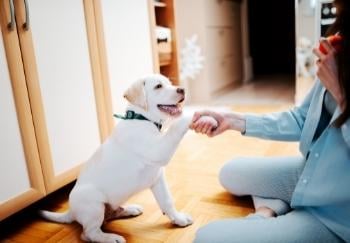 Teach Your Puppy What "Yes!" Means
Teach Your Puppy What "Yes!" Means
We humans tend to be very good at saying "no."Too good at it, in fact. But your puppy literally does not know what "no" means, and it's useless to try and teach them that unless they also know what "yes" means! And teaching your puppy "yes" is the first step in obedience training. It's how we tell them what they got right and what they should do more of.
- Any time your puppy does something that you like, say "yes!" and give them a treat.
- Any time your puppy does something you want to see more of in the future, say "yes!" and give them a treat.
Think of this as creating a shared language between you and your dog. Being able to understand each other means that training will be more fun — and less frustrating! — for both you and your pup. A side benefit of teaching your puppy "yes," is that it changes your own mindset. Instead of only reacting to unwanted behaviors after the fact, you're actively seeking out the positive behaviors and rewarding them. The more a behavior is rewarded, the more it becomes a habit.
With consistency, your puppy will build polite habits and choose to do these things over and over again. Finding moments for "yes!" is easier than you might think – you just have to look for them. Check out this video of Finnegan the puppy and me playing a game of tug, where I'm using the opportunity to say "yes!" whenever he drops the toy — it's training and fun all rolled into one:
For more tips on building clear communication with your puppy, check out these articles:
- How to Speak Your Dog's Language
- An Introduction to Clicker Training
- How to Teach Your Dog to Do Anything in 4 Steps
Don't Go It Alone
Your dog trainer and veterinarian are here to support you as you raise your new puppy. You can't — and shouldn't — go it alone! Your veterinarian can also help you ensure your new puppy stays healthy and safe during their socialization period and connect you with training professionals in your area. Need help finding a veterinarian for your puppy? Check out this VetStreet directory or search the American Animal Hospital Association (AAHA) directory.
 Finding a certified trainer to work with you and your puppy means you have someone to ask about your puppy’s behavior, help you plan and properly introduce socialization, troubleshoot any potty training issues, and can get your puppy started in well-run puppy socialization classes or puppy playdates.
Finding a certified trainer to work with you and your puppy means you have someone to ask about your puppy’s behavior, help you plan and properly introduce socialization, troubleshoot any potty training issues, and can get your puppy started in well-run puppy socialization classes or puppy playdates.
Often, my puppy clients just need someone to talk to about the frustration they’re feeling and take comfort in hearing that their puppy is just being a normal puppy, albeit an exhausting one, and they are doing the right things. It really does take a village!
Unsure about how to hire the best trainer for you and your puppy? Learn more here about What You Should Ask a Dog Trainer (and What Their Answers Should Be). To find a certified trainer near you, check out the CCPDT Trainer Directory or the IAABC Consultant Directory.



